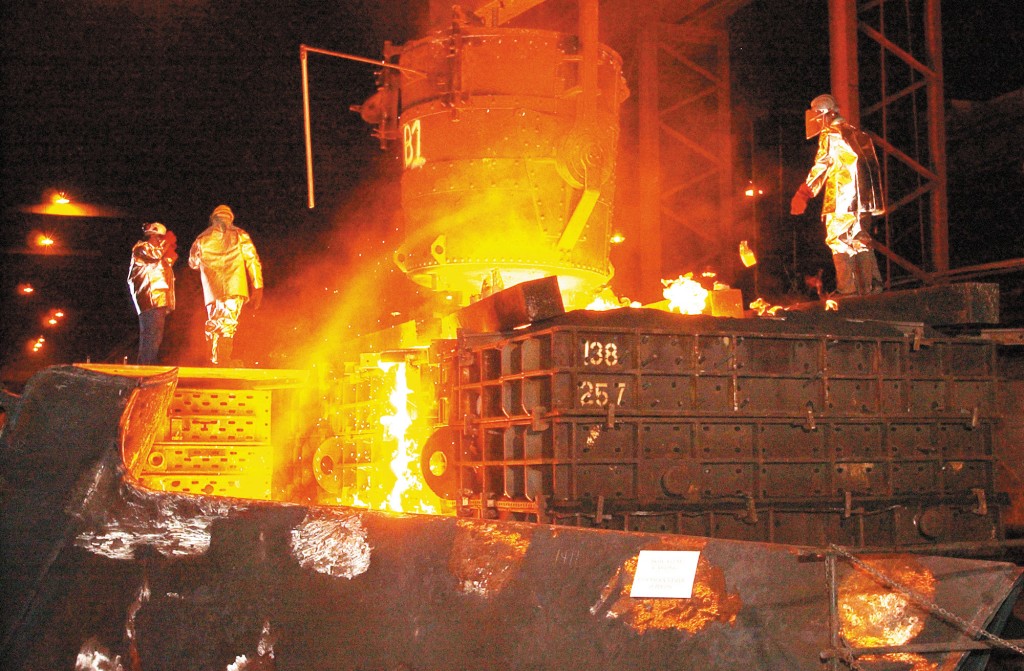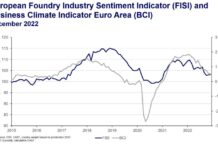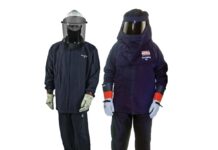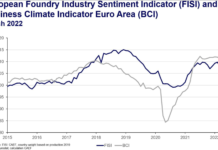 A range of design and organizational actions conceived to turn a conventional cast iron foundry into a production plant with very low environmental impact. The interventions involve all the aspects of the casting process and of the production management: from the electrical energy saving to the optimal heat exploitation, passing throuh the reduction of dusts and odours, up to the waste recovery. This feasibility study has been implemented by the Bologna University at SCM Foundry in Rimini (Italy) and is framed in a wider intervention financed by the Emilia Romagna region to support research and growth.STOPPING ODOURS
A range of design and organizational actions conceived to turn a conventional cast iron foundry into a production plant with very low environmental impact. The interventions involve all the aspects of the casting process and of the production management: from the electrical energy saving to the optimal heat exploitation, passing throuh the reduction of dusts and odours, up to the waste recovery. This feasibility study has been implemented by the Bologna University at SCM Foundry in Rimini (Italy) and is framed in a wider intervention financed by the Emilia Romagna region to support research and growth.STOPPING ODOURS
This industrial research intervention set the target of implementing and studying complex components/solutions needed to validate the investigated technologies and to develop all those due methodological and plant engineering solutions involved in the purpose of detecting, monitoring and, finally, reducing unpleasant odours.
The so called bad smell can depend on the presence in the air of a big variety of molecular substances, often organic, which, even if present in very low concentration, can cause a significant nuisance. The odour becomes, then, a very complex phenomenon to be studied and fought, for which a regulation does not exist, yet, also considering that it represents more a problem of discomfort rather than of toxicity.
The environmental analyses carried out in foundry highlight that the substances generating a bad smell are completely harmless for the health of workers and of the area inhabitants. Nevertheless, also owing to the particular position of the company, the will of drastically reducing social problems is high and as important is the target of consolidating the image of the foundry as a really up-to-date company, concretely interested in producing in compliance with utmost environment protection.
The most conventional interventions of reduction (for instance the implementation of new insulation walls) and conveyance of odours are completed by a series of studies, such as: the development of a prototype device for the capture of odours, their experimental detection, the chemical recognition by measuring their possible toxicity, the mapping of emission sources, the definition of sensitive zones, the simulations of diffusion in the company and outside and still more.
But the strong innovation resides in the development and adoption of a prototype system for the reduction of odours through biological filters that, fed by organic molecules, purify the air making it pleasant to smell.
To give objective and measurable evidence to odour emissions, the thresholds of perceptibility of the odours sampled in foundry will be statistically assessed on a tester sampling through the olfactometric method by certified Dynamic Olfactometry laboratories. They estimate that this kind of interventions can lead to the 50% reduction in the odour concentration at the project start, measured in odorimetric units according to the EN 13725 regulation.
The scheduled activities are the following:
- Preliminary collection of information about the molecular characteristics of industrial odours;
- State-of-the-art of the monitoring systems of odour emissions for industrial purposes;
- Research, acquisition and operating starting up of the sensors needed for the odour monitoring;
- Experimental measuring of sensor efficiency in detecting odours (in the various concentrations);
- Experimental pre-screening of the odour typology present in foundry;
- Recognition of molecules and assessments of possible toxicity problems;
- Design of an integrated system for measuring odour emissions in foundry;
- Qualitative and quantitative evaluation of odour emissions in foundry (that’s to say the odour map);
- Technical analysis of the various production processes and of their contribution in the odour generation;
- Study of solutions for the reduction and conveyance of odours;
- Study of solutions for the odour reduction (bio-filter plant);
- Campaigns of odour emission measuring, both indoor and outdoor, to assess the efficiency in the odour reduction (under the different working and atmospheric conditions).
The expected results are the following:
- Basic know-how concerning the problem of industrial odours and associated chemistry;
- Specific know-how regarding solutions for the detection of industrial odours;
- Specific know-how inherent to solutions for industrial odour filtering by means of bio-filters;
- Systems of portable sensors and devices for the detection of particular molecules that create bad smell;
- Integrated sensor system for the monitoring of odour emissions;
- Maps of odours for foundry with indication of the different emission points;
- An analysis document of odour emissions connected with productive process changes;
- Plant engineering solutions for the reduction and conveyance of odour emissions;
- Prototype odour filtering plant through bio-filters;
- Internal protocol for the environment protection in terms of odour knocking-down;
- Improvement of the working conditions in production departments due to the odour reduction;
- Improvement of the environment outside the foundry thanks to the odour reduction with halving of Odorimetric Units (OU) emitted today;
- Certification document of the attained improvements in terms of odour reduction;
RECOVERING WASTES
This action of experimental development set the target of studying and making operational a whole range of technical and organizational solutions in order to maximise the recovery of waste materials in foundry.
The strategies of recovery and reuse of primary and auxiliary materials in foundry (like for instance slag and refractory materials), including the particulates contained in fumes (for instance carbide and dusts); their reconditioning and reintegration into the machining cycle spring from the requirements of highest environmental protection and minimum impact on the eco-system of the industrial activity as well as from considerations of economic sustainability in the long run.
But to reduce emissions and wastes means, in the end, to decrease the entropy of processes thus preserving energies and materials, turning these policies into a rational instrument to optimize resources and to maximise competitiveness. The strategic target consists in notably decreasing the percentage of waste material to be transported to the dumping even preserving the highest competitiveness at the time of the recovery solution choice.
We are going to demonstrate how the environment protection can turn into good business through the adoption of forefront technical and organizational solutions. The exhausted sand can be used in the manufacturing of cores through the new cold box process that can use up to over 70% of worn-out sand (and opportunely retreated), mixing it with virgin sand for the remaining part. Experimental solutions allow the recovery of furnace dusts and carbide, with direct reintroduction into the tuyères of the cupola furnace. These activities will have the target of a generalized reduction of the environmental impact of foundry processes according to a double environmental and economic value deriving from a notable rise of the qualitative standards of process and of products.
The scheduled activities are the following:
- State of the art of the recovery systems of exhausted materials in industrial and foundry ambit;
- Study and modelling of foundry processes according to worn-out materials;
- Qualitative and quantitative assessment of exhausted materials in foundry (waste map and LCC type analysis);
- Technical hypotheses about disposal, recovery and reconditioning of exhausted materials;
- Assessments of technical feasibility and economic convenience of recycling solutions;
- Technical document for the implementation of a zero slag clean foundry;
- Study and development of implementation solutions for the recovery and reconditioning/recycling of moulding sands (the example is the cold box);
- Study and development of implementation solutions for the recovery and reconditioning/recycling of fine fumes/dusts;
- Study and development of implementation solutions for the recovery and reconditioning/recycling of coarse dusts;
- Study and development of implementation solutions for the recovery and reconditioning/recycling of metal chips, gating and risers;
- Assessment of the recycling and reuse degree achieved (a new map of wastes).
The expected results are:
- Know-how concerning the problem of the recovery of industrial wastes and related solutions;
- Integrated recovery and reconditioning system for all foundry wastes;
- Recovery and reconditioning of moulding sands up to 80% through cold-box process and up to 98% through other internal recoveries;
- Recovery and reconditioning of furnace slag and byproducts of metal treatment up to 90%;
- Recovery and reconditioning of combustion fumes and carbides with maximum 90% recycling in casting processes;
- Recovery of dusts in other industrial sectors such as tile, cement and bituminous factories (reduction of transfers up to values not exceeding 1% of the incoming material);
- Reduction of the quantities of material to be transferred to the landfill and/or to be disposed through alternative ways amounting to at least 2,000 tons per year;
- Certification document of the improvements obtained in terms of recovery of waste materials.
CASTING IN COMPLIANCE WITH MAN AND ENVIRONMENT PROTECTION
This Industrial Research action aims at creating an ICT platform (that’s to say based on information and communication technology) for the continuous monitoring and the real time intervention on the productive system in order to assure the best eco-sustainability of the process.
The intervention, carried out according to a Virtual factory approach, aims at the definition and development of a single control and simulation system, as integration of the subsystems developed inside previous OR.
The central system can acquire the signal flows coming from a large typology of sensors diffused in the plant, turn them into ITC traffic, manage them at hierarchical level and finally structure them opportunely according to the various uses. The intervention intends then to develop cutting-edge methodologies for the data reprocessing, the simulation and the activation of automatic intervention logics oriented to the development of expert systems for the foundry management. Real time information can be made available for the personnel through specific outputs (for instance, performance indexes and sound alarms) and customized according to the purpose type. This supervision system allows also monitoring the foundry in time with the control of possible danger level overcoming as warrantee of the constant improvement of eco-sustainability in production.
The scheduled activities are the following:
- Study of a system for the monitoring in continuous of the plant energy consumptions;
- Study of a system for the monitoring in continuous of consumptions and heat dissipations;
- Study of a system for the monitoring in continuous of fumes and dust emissions;
- Development and integration of systems in a single ICT platform of environmental monitoring (the supervisor);
- Study and validation of algorithms for the simulation of the eco-sustainability level of processes (for aspects like efficiencies, heat dissipations and fume emissions);
- Definitions of rules and intervention logics on the plant as warranty of the highest eco-sustainability level of processes and productions;
- Implementation (in the plant supervisor) of an expert system, (through fuzzy algorithms educated in self-teaching), for the automatic regulation of intervention logics;
- Definition of internal certification protocols for the energy labelling of processes;
- Definition of protocols for the energy labelling of the single product (Embedded energy).
The expected results are the following:
- Specific know-how in the field in some specific ICT ambits;
- Supervision system for the monitoring of environmental aspects;
- Expert system (supporting the operator) for the semi-automated management of the plant;
- Better process control and productivity rise;
- Standardization of intervention methods and procedures for problem-solving;
- Better plant management thanks to the availability of a “historical file” of operation data;
- Better service level for customers: the “consistency” of processes leads to higher predictability and reliability in the levels of response to customers;
- Investment protection: the integration capacity of these systems allows the total or partial reuse of existing computer applications;
- Certification procedure on the energy impact of the main processes;
- Certification procedure of the energy needs of products (Embedded energy).



